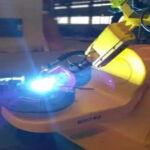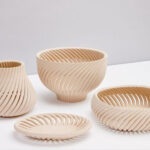In the past few decades, metal 3D printing has pioneered the creation of custom parts with complex shapes and powerful functions. But as additive manufacturers add more alloys to their 3D printing needs, they face challenges in creating uniform, defect-free parts.
A new study by researchers at Texas A&M University has further refined the process of using laser powder bed fusion 3D printing technology to manufacture high-quality metal parts. By using a combination of machine learning and single-track 3D printing experiments, they determined favorable alloy chemical composition and process parameters, such as laser speed and power, which are required to print parts with uniform characteristics on a microscopic scale.
Raiyan Seede, a PhD student in the Department of Materials Science and Engineering, said that our initial challenge was to ensure that there are no pores in the printed part, as this is a clear threat to creating objects with enhanced mechanical properties. But after solving this challenge in our previous work, in this research, we delved into the fine-tuning of the alloy’s microstructure in order to better control the characteristics of the final printed object at a finer scale than before.
The researchers published their findings in the journal Additive Manufacturing.
Table of Contents
Like other 3D printing methods, laser powder bed fusion can also build 3D metal parts layer by layer. The process first rolls a thin layer of metal powder on the substrate, and then uses a laser beam to melt the powder along a trajectory that traces the cross-sectional design of the desired part. Then, apply another layer of powder and repeat the process, gradually building the final part.

The alloy metal powders used in additive manufacturing may be very diverse, including metal mixtures such as nickel, aluminum, and magnesium in different concentrations. During the printing process, these powders are rapidly cooled after being heated by the laser beam. Since each metal in the alloy powder has very different cooling characteristics, and therefore solidifies at different speeds, this mismatch will produce a kind of micro-defect called micro-segregation.
When the alloy powder cools, individual metals will precipitate out, Seede said. Imagine pouring salt into water. When the amount of salt is small, it will dissolve immediately, but when you pour more salt, the undissolved excess salt particles begin to precipitate out as crystals. Essentially, this is what happens in our metal alloys that cool quickly after printing.
He said that this defect manifests itself as tiny pockets that contain a slightly different concentration of metal content from other areas of the printed part. These inconsistencies can damage the mechanical properties of the printed object.
To correct this micro-defect, the research team studied the solidification process of four alloys containing nickel and one other metal component. In particular, for each of these alloys, they studied the physical states or phases that exist at different temperatures to increase the concentration of other metals in nickel-based alloys. Based on the detailed phase diagram, they can determine the chemical composition of the alloy to minimize micro-segregation during the additive manufacturing process.
Next, they melted a single track of alloy metal powder for different laser settings, and determined the process parameters that can produce non-porous parts. Then, they combined the information collected from the phase diagram with the information collected from the single-track experiment to obtain a comprehensive view of the laser settings and nickel alloy composition, which would produce a non-porous printed part without microscopic appearance. Segregation.
Finally, the researchers went one step further and trained machine learning models to recognize patterns in single-track experimental data and phase diagrams to develop micro-segregation equations applicable to any other alloy. Seede stated that the equation aims to predict the degree of segregation based on the solidification range, material properties, and laser power and speed.
Ibrahim Karaman, Professor of Chevron I and Head of the Department of Materials Science and Engineering, said that our method simplifies the process of successfully using alloys of different compositions in additive manufacturing without worrying about introducing defects, even on a microscopic scale. The work will be of great benefit to the aerospace, automotive and defense industries, which are always looking for better ways to manufacture custom metal parts. ”
Research collaborators Raymundo Arroyavé and Alaa Elwany added that their method is unique in its simplicity and can be easily adopted by the industry to make robust, defect-free parts using the alloy of choice. They point out that their method contrasts with previous efforts to optimize processing conditions that mainly relied on expensive and time-consuming experiments.
Link to this article: Adjust the alloy microchemistry to achieve perfect metal 3D printing
Reprint Statement: If there are no special instructions, all articles on this site are original. Please indicate the source for reprinting:https://www.cncmachiningptj.com/,thanks!
 PTJ® provides a full range of Custom Precision cnc machining china services.ISO 9001:2015 &AS-9100 certified. 3, 4 and 5-axis rapid precision CNC machining services including milling, sheet metal to customer specifications,Capable of metal & plastic machined parts with +/-0.005 mm tolerance.Secondary services include CNC and conventional grinding, laser cutting,drilling,die casting,sheet metal and stamping.Providing prototypes, full production runs, technical support and full inspection.Serves the automotive, aerospace, mold&fixture,led lighting,medical,bicycle, and consumer electronics industries. On-time delivery.Tell us a little about your project’s budget and expected delivery time. We will strategize with you to provide the most cost-effective services to help you reach your target,Welcome to Contact us ( [email protected] ) directly for your new project.
PTJ® provides a full range of Custom Precision cnc machining china services.ISO 9001:2015 &AS-9100 certified. 3, 4 and 5-axis rapid precision CNC machining services including milling, sheet metal to customer specifications,Capable of metal & plastic machined parts with +/-0.005 mm tolerance.Secondary services include CNC and conventional grinding, laser cutting,drilling,die casting,sheet metal and stamping.Providing prototypes, full production runs, technical support and full inspection.Serves the automotive, aerospace, mold&fixture,led lighting,medical,bicycle, and consumer electronics industries. On-time delivery.Tell us a little about your project’s budget and expected delivery time. We will strategize with you to provide the most cost-effective services to help you reach your target,Welcome to Contact us ( [email protected] ) directly for your new project.
Link to this article:Adjust the alloy microchemistry to achieve perfect metal 3D printing
Reprint Statement: If there are no special instructions, all articles on this site are original. Please indicate the source for reprinting.:Cnc Machining,Thank!^^








